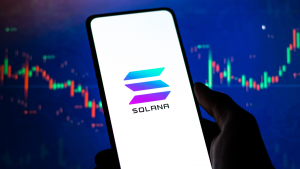Bitcoin (BTC-USD) has been on a tear lately, with the price of the world’s largest cryptocurrency recently surpassing $49,000 per token at the time of writing. However, while Bitcoin is set up for more potential gains in 2024 due to major catalysts like the upcoming halving in April, savvy crypto investors know that smaller altcoins can often outperform Bitcoin, especially during bull market cycles.
I will look at seven cryptos that I believe have the potential to outperform Bitcoin’s returns in 2024. A smaller market capitalization leaves a lot of room for upside. That said, some of these picks are still established names that should deliver steady returns, with the majority of these picks centered around more speculative “moonshot” bets that could exponentially increase in value if certain catalysts play out. Let’s dive in!
Ethereum (ETH-USD)

Source: shutterstock
Ethereum (ETH-USD) has outperformed Bitcoin in every cycle since its inception, and I believe this cycle will be no different. As the primary driver behind Web 3.0 innovation, Ethereum seems poised for tremendous growth in 2024.
The top decentralized applications and NFT projects continue to be built on Ethereum, cementing its status as the leading smart contract platform.
Importantly, Ethereum recently transitioned to a proof-of-stake consensus model. This greatly reduced the issuance rate of new Ethereum tokens, making the world’s second-largest cryptocurrency deflationary for the first time. With Ethereum’s burn rate now exceeding that of its mint rate, a supply shock could strongly benefit prices. Additionally, as more developers build Web 3.0 apps on Ethereum, demand for Ethereum via transactions on its network should continue climbing.
I’m especially bullish on Ethereum due to this network’s ties to some of the most promising metaverse, DeFi, and NFT projects that rely on the Ethereum network. These applications relay on Ethereum to power transactions and run smart contracts. As these nascent sectors grow, Ethereum adoption should surge as well. With strong network effects firmly in place, I expect Ethereum to continue to outpace Bitcoin’s gains.
Ethereum also boasts top-notch security with its large community of validators. Attacks are virtually impossible at this scale. Thus, with no serious “Ethereum killer” in sight yet, Ethereum enjoys a dominant position in the world of Web 3.0 infrastructure. Unless unforeseen circumstances arise, I believe the runway is clear for Ethereum to exponentially increase in value in 2024.
Kaspa (KAS-USD)

Source: shutterstock.com/Lemonsoup14
Scalability remains one of the biggest challenges in the crypto realm. However, Kaspa (KAS-USD) offers an elegant solution with its cutting-edge blockDAG protocol called GHOSTDAG.
Unlike traditional blockchains, GHOSTDAG leverages a directed acyclic graph structure. This allows parallel blocks to coexist, while allowing the network to maintain quick consensus ordering. As a result, Kaspa can handle extremely high throughput with miniscule transaction confirmation times.
Innovative architectures like GHOSTDAG will become highly valued as scalability pressures increase across decentralized networks. By avoiding the inefficiency of wasted orphaned blocks, Kaspa unlocks a lean and effective scaling approach that is not bogged down by excessive hardware requirements.
From my first recommendation of Kaspa back at 2 cents back in July 2023, this token has already climbed 600% to 14 cents at the time of this writing. Yet, its current $3-billion market cap still seems small compared to its potential. As developers recognize the scalability promise of GHOSTDAG, Kaspa could achieve a market cap of $10 billion or more.
In an era where high Ethereum fees occasionally throttle applications, blockchain projects would do well to evaluate alternatives like Kaspa. Its novel hybrid PoW/PoS consensus and ability to run public and private networks make Kaspa surprisingly versatile. For these reasons, I believe this project has plenty of upside ahead, despite already generous gains for early investors.
Libra Incentix (LIXX-USD)

Source: Marko Aliaksandr/ShutterStock.com
Libra Incentix (LIXX-USD) seems positioned for a major breakout in 2024 driven by high-profile partnerships at the intersection of sports and commerce. Libra’s loyalty platform has teamed up with ComAve, an online shopping portal which has surged in popularity due to its partnerships with major football clubs like AC Milan and Crystal Palace.
Additionally, Libra Incentix is collaborating with Tamias POS, which also continues to secure deals with prominent sports teams and brands. As the exclusive loyalty token provider for these platforms, Libra offers fans a tokenized incentive program.
This focus on mainstream sports partnerships marks just the initial phase in Libra becoming the most widely adopted crypto loyalty solution. By catering to the massive global sports fan demographic, Libra Incentix can drive significant organic user growth and transaction volume for its network.
The opportunities appear tremendous still. The sports industry is on pace to reach a staggering $681 billion valuation by 2031, and I think this number could be higher as it benefits from crypto adoption.
With LIXX serving as the backbone loyalty mechanism across multiple major players in this booming niche, this project’s real-world usage is set to accelerate exponentially. As the LIXX token becomes deeply integrated into mainstream fan experiences and shopping through influential partners, Libra may emerge as one of the most promising crypto projects in terms of user reach.
Solana (SOL-USD)

Source: sdx15 / Shutterstock.com
While Ethereum remains the dominant smart contract platform, “Ethereum killers” like Solana (SOL-USD) have managed to carve out solid market share in areas like NFTs. With transaction fees under 1 cent, Solana provides a fast and ultra-affordable blockchain environment for developers. This has fueled tremendous adoption, despite Solana’s previous struggles with stability (given a number of big outages).
However, the Solana team continues refining the network, and outages are becoming less frequent. As demand for scalable Layer 1 solutions grows exponentially in 2024 and beyond, Solana’s upside remains enormous at these levels.
Unless catastrophic failures occur, significant market share gains from Ethereum seem likely as congestion and high gas fees push developers to seek alternative platforms to build on. I think Solana’s unique infrastructure could solve Ethereum’s speed and cost problem, making this a top token to consider for long-term growth.
Aleph Zero (AZERO-USD)

Source: iQoncept / Shutterstock
Aleph Zero (AZERO-USD) represents another emerging Ethereum competitor that aims to resolve lingering issues like congestion and uptime struggles. Leveraging a novel consensus protocol, Aleph Zero has achieved exceptional transaction finality in under one second, while being able to handle tens of thousands of transactions per second.
However, Aleph Zero’s design compromises raw decentralization for that speed. With just 162 validators securing the network, it utilizes a model similar to Tron (TRX-USD). Still, Aleph Zero directly tackles recurring network capacity and stability problems developers face. With robust functionality catering to builders through EVM support, NFT/token capabilities, and multi-language SDKs, Aleph Zero remains well-positioned to capture dissatisfied talent if ecosystems like Ethereum and Solana stall in providing reliable infrastructure.
Considering its relatively tiny $188 million market cap, Aleph Zero offers tremendous upside potential if it attracts an influx of builders and users over the coming years as part of the next generation of blockchain ecosystems.
Render Token (RNDR-USD)

Source: Maurice NORBERT / Shutterstock.com
Render (RNDR-USD) is a decentralized GPU render farm and 3D visualization platform. It is primed to capture tremendous growth as demand for computer graphics and GPU compute resources scales exponentially with trends like the metaverse, AR/VR, 3D modeling, and video gaming.
The Render network has already rendered 2.36 million frames in Q3 2023, using GPU capacity provided by regular computer owners looking to passively earn crypto. As more digital assets get created for emergent digital worlds and immersive experiences, Render’s spare capacity becomes extremely valuable.
While RNDR currently trades 47% below its 2021 high, I expect surging adoption once crypto markets turn bullish again. Relative price resilience shows institutional interest in this low-key project. With a fixed token supply and staking incentives, Render has major upside as its network usage expands.
Injective (INJ-USD)
Decentralized finance has seen tremendous growth recently. However, I would argue that DeFi remains an under-appreciated crypto sector. That’s because DeFi provides a central value proposition for the entire cryptocurrency sector, enabling private, decentralized financial access.
Injective Protocol (INJ-USD) is one DeFi project uniquely-positioned for massive upside. In recent weeks, Injective has gained traction by offering robust decentralized trading infrastructure for next-generation DeFi innovation. This infrastructure includes a fully on-chain order book resistant to exploitation.
Additionally, Injective fully supports all major financial instrument types on-chain, including spot contracts, futures, perpetual contracts, and options. Its Cosmos-based blockchain leverages the Tendermint consensus for instant trade finality and lightning-fast 10,000+ transactions per second throughput.
Advanced interoperability and bridging across Ethereum, alternative networks like Solana, and non-EVM chains also gives Injective a key advantage. It basically provides the flexible core “Lego pieces” for developers to build multi-chain DeFi products.
As the cryptocurrency sector gets further integrated into mainstream finance over time, critical backbone infrastructure projects like Injective seem primed to benefit.
On the date of publication, Omor Ibne Ehsan did not hold (either directly or indirectly) any positions in the securities mentioned in this article. The opinions expressed in this article are those of the writer, subject to the InvestorPlace.com Publishing Guidelines.





